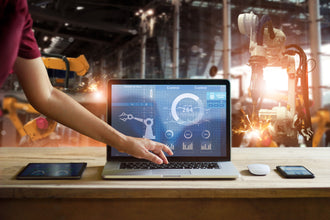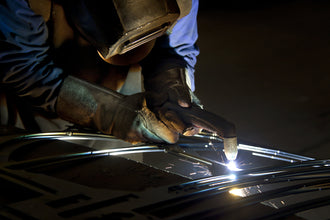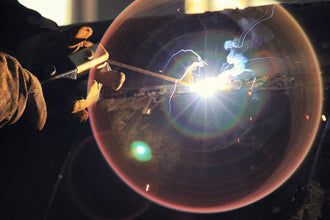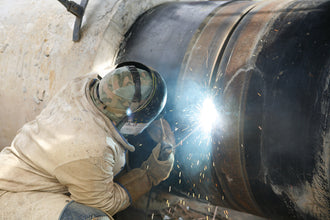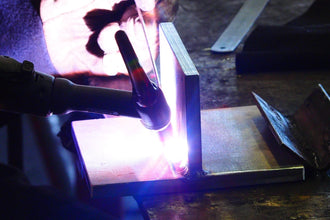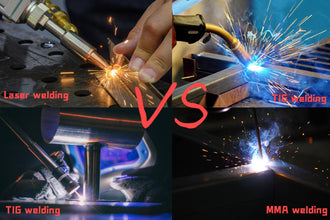
Introduction: Sparks in the Machine
The drumbeat of artificial intelligence (AI) is everywhere. From algorithms that predict our shopping habits to systems that diagnose disease, the narrative often suggests that no profession is safe from automation.
In manufacturing and construction, the specter of robotic arms tirelessly performing tasks once done by human hands looms large. It’s easy to look at the precise, repetitive motions of an automated welding cell and assume the welder’s days are numbered. However, this perspective fundamentally misunderstands the nature of welding itself. It is not a simple, mechanical task; it is a complex fusion of art, science, intuition, and physical mastery.
This article will delve deep into the multifaceted reasons why AI will never replace the expertise of welders. While AI and automation are powerful tools that can augment and enhance the welding profession, the core of welding—the nuanced judgment, the adaptive problem-solving, and the tactile genius—remains an irreplaceably human domain. The future is not about human versus machine, but about human and machine, working in concert to achieve what neither could alone.

The Deceptive Simplicity of the Arc: What Welding Truly Entails
To the uninitiated, welding looks straightforward: an electric arc melts metal to join two pieces together. This superficial view is precisely why many believe it's ripe for full automation. However, breaking down the process reveals a staggering depth of complexity that challenges even the most advanced AI.
Beyond the Bead: Welding as a Dynamic Physical Science
Every weld is a live physics and chemistry experiment. A welder is not just operating a tool; they are managing a miniature, localized foundry. They must account for:
-
Metallurgy: Understanding how different base metals and filler metals interact. How will the heat affect the crystalline structure of the steel, aluminum, or titanium? What about carbon content, alloying elements, and their behavior under extreme temperatures?
-
Thermodynamics: Managing heat input is a constant balancing act. Too little heat results in lack of fusion and a weak bond. Too much heat can cause warping, burn-through, or a weakened Heat-Affected Zone (HAZ). The welder feels this heat, sees its effect on the metal's color and behavior, and adjusts in real-time.
-
Electrical Principles: Understanding the relationship between voltage, amperage, and wire feed speed is just the beginning. The subtle adjustments to these parameters based on material thickness, joint type, and position are a form of high-stakes intuition.
This scientific knowledge isn't just theoretical; it's applied instantaneously and physically. This is a key reason why AI will never replace the expertise of welders—because their expertise is a continuous, sensory feedback loop of applied science.
The Unwritten Code: Interpreting Blueprints and Specifications
A welding procedure specification (WPS) is a detailed document outlining exactly how a weld should be performed. However, these documents are not always perfectly translated to the real world. A welder must:
-
Interpret Ambiguity: A blueprint might not account for a slight misalignment in the fit-up or an unexpected material variance.
-
Understand Intent: They must grasp the purpose of the weld—is it a critical structural joint for a skyscraper, or a non-critical cosmetic seam? This understanding dictates the level of perfection required.
-
Sequence and Plan: On a large project, the order in which welds are made is critical to control distortion. This requires a holistic, strategic understanding of the entire assembly process, something that goes far beyond the scope of a single, automated task.
This interpretive skill is a cognitive function that blends experience with spatial reasoning, a area where the rigid logic of AI often struggles with the fluidity of real-world conditions.

The Limits of Artificial Intelligence in the Welding Bay
AI excels in environments with clear rules, vast amounts of structured data, and predictable outcomes. The welding bay, especially in custom fabrication, repair, and construction, is the antithesis of such an environment.
The "Unstructured Environment" Problem
A robotic welding cell in a factory is a marvel of engineering, but it operates in a highly controlled, structured environment. The parts are presented in the exact same position, every time. The lighting, temperature, and conditions are constant. Now, place that same robot on a construction site or in a shipyard. The challenges are immense:
-
Varied Fit-Ups: No two pieces fit together perfectly. Gaps, misalignments, and warping are the norm, not the exception. A human welder sees a gap and instinctively knows to adjust their technique—perhaps using a weave pattern, changing the travel speed, or adding more filler metal. An AI-powered robot would need to be reprogrammed or would simply fail.
-
Environmental Variables: Wind can blow away shielding gas, moisture can contaminate a joint, and ambient temperature can drastically alter heat dissipation. A welder feels the wind, sees the condensation, and adapts. An AI system would require a complex array of sensors and a pre-programmed response for every possible combination of variables, which is practically impossible.
This fundamental inability to handle the chaos and unpredictability of real-world fabrication sites is a primary reason why AI will never replace the expertise of welders.

The Data Dilemma: Tacit Knowledge vs. Explicit Data
AI is powered by data. It learns from thousands or millions of examples. But welding proficiency is built on something far less quantifiable: tacit knowledge.
-
Tacit Knowledge: This is the knowledge that is difficult to transfer to another person by means of writing it down or verbalizing it. It's the "feel" for the puddle. It's the sound of a correct arc—a crisp sizzle like bacon frying. It's the subtle visual cues of the molten metal that indicate penetration and fusion. How do you codify that into data for an AI? You can't.
-
The "Muscle Memory" of Craft: Years of practice build neural pathways and muscle memory that allow a welder to maintain a steady hand, a consistent travel speed, and a precise arc length almost subconsciously. This physical, embodied intelligence is entirely outside the realm of AI's current capabilities.
The argument for why AI will never replace the expertise of welders hinges on this distinction. AI can process explicit data (amperage, voltage), but it cannot acquire the tacit, sensory-based knowledge that is the hallmark of a master craftsman.

Lack of True Creativity and Problem-Solving
When a critical piece of equipment breaks down in a remote location, there isn't always a perfect replacement part or an ideal welding procedure. This is where the welder becomes an innovator.
-
MacGyver-like Ingenuity: A seasoned welder might have to use a non-standard rod, weld out of position in a confined space, or even build up a worn part from scratch with no blueprint. This requires creative, on-the-fly problem-solving.
-
Diagnostic Intuition: Why did this weld crack? A welder acts as a forensic materials scientist. They examine the crack pattern, the color of the metal, the structure of the bead, and use their experience to diagnose the root cause—was it hydrogen embrittlement, fatigue, or a slag inclusion? This diagnostic reasoning is a deeply human cognitive process.
AI operates on correlation, not causation. It might identify that a certain parameter often leads to cracks, but it cannot understand the why in the way a human expert can, and it certainly cannot devise a novel, creative solution to a problem it has never seen before.

The Irreplaceable Human Touch: Core Competencies of the Expert Welder
Let's crystallize the specific human competencies that form an insurmountable moat against full automation.
Sensory Perception and Intuition
An expert welder is a symphony of sensory input. They are not just looking at a screen or listening for an alarm; they are fully immersed in the process.
-
Sight: They read the weld puddle like a book. Its size, shape, fluidity, and color tell them everything about penetration, heat, and travel speed. They can see ahead of the arc to anticipate problems.
-
Sound: The sound of the arc is a direct diagnostic tool. A sharp, crackling sound indicates a good setting. A hum, a pop, or a hiss signals an issue with gas, voltage, or stick-out.
-
Smell and Touch: Even the smell of the welding fumes or the way the rod burns can provide clues. The vibration through the hood and the feel of the gun in their hand provide a constant tactile feedback loop.
This multi-sensory intuition, developed over thousands of hours, is something that cannot be replicated by even the most advanced sensor suite and algorithm. This sensory mastery is a powerful argument for why AI will never replace the expertise of welders.
Judgment, Accountability, and Responsibility
Welding is often a matter of life and death. A faulty weld on a bridge, a high-pressure pipeline, or a spacecraft can have catastrophic consequences.
-
Ethical Judgment: A welder has the authority and the responsibility to say, "This is not right." They can stop the production line if the fit-up is poor or the materials are suspect. An AI follows its programming; it has no concept of ethics or consequence.
-
Accountability: When a weld is certified, a human being puts their name and reputation on the line. That accountability is a powerful driver of quality. Who is accountable for an AI's weld? The programmer? The operator? The company that owns it? This legal and ethical gray area ensures that for critical applications, a human expert will always be the final authority.
The need for human judgment and accountability in high-stakes industries is a fundamental reason why AI will never replace the expertise of welders.
Adaptability and Versatility
A single master welder is a one-person fabrication shop. In the course of a week, they might:
-
Monday: Use Gas Tungsten Arc Welding (GTAW/TIG) to weld paper-thin aluminum for a custom motorcycle part.
-
Tuesday: Use Shielded Metal Arc Welding (SMAW/Stick) to repair a thick steel beam on a construction site in the rain.
-
Wednesday: Use Flux-Cored Arc Welding (FCAW) to build a large structural frame indoors.
-
Thursday: Use Oxy-Acetylene welding to braze a copper pipe.
This incredible versatility across processes, materials, and environments is light-years away from the capabilities of even the most flexible robotic system. The economic and practical impossibility of creating a single machine that can replicate this range of human skill solidifies the argument for why AI will never replace the expertise of welders.

The True Future: Collaboration, Not Replacement
The most productive and realistic path forward is not a battle for supremacy, but a partnership. AI and robotics are not the enemies of the welder; they are the next generation of tools.
Augmentation, Not Automation: The Welder as a Conductor
Think of the future welder not as a manual laborer, but as a conductor of an automated orchestra. Their role will elevate to:
-
Programming and Oversight: They will program and supervise robotic welding cells, using their expertise to set parameters and troubleshoot issues the robot cannot handle.
-
Leveraging AI-Powered Tools: They will use AI-enhanced welding helmets that display real-time data overlay, highlighting potential defects as they weld. They will use systems that provide haptic feedback to guide their hand.
-
Handling Complex, One-Off Tasks: Robots will handle the high-volume, repetitive welds, freeing up the human experts to focus on the complex, custom, and critical welds that require true ingenuity.
This collaborative model enhances productivity, improves consistency on repetitive tasks, and allows human expertise to be applied where it adds the most value. It is the ultimate expression of why AI will never replace the expertise of welders—because their expertise is needed to guide and control the AI itself.
The Evolving Skillset: From Torch Handler to Tech-Savvy Fabricator
The welder of the future will need to be more skilled than ever. They will need to be proficient in:
-
Robotics programming and integration.
-
Interpreting data from advanced sensing systems.
-
Computer-Aided Design (CAD) and Computer-Aided Manufacturing (CAM).
-
Traditional metallurgy and welding theory, now more important than ever to effectively manage automated systems.
This evolution makes the profession more intellectually demanding and more valuable, further cementing its place in the advanced manufacturing ecosystem.

Conclusion: The Eternal Spark
The narrative of AI as a job-destroying force is simplistic and, in the case of welding, fundamentally incorrect. Welding is not a mere procedure; it is a craft. It is a profession that sits at the intersection of hard science and intuitive art. The sparks that fly from an arc are a testament to a process that is as much about human judgment, sensory perception, and adaptive intelligence as it is about melting metal.
AI will never replace the expertise of welders because that expertise is rooted in the human capacity to handle ambiguity, to learn through embodied experience, to take responsibility, and to create solutions where none previously existed. The future is bright, not for machines alone, but for skilled welders who embrace new technology, using it to amplify their irreplaceable talents. The torch has been passed through generations of craftsmen, and while the tools may change, the essential spark of human expertise will continue to light the way.
No matter what kind of welding machine you need, Doughty Welder can provide for your needs. Contact our sales team if you need advice beyond what this article provides. Our team of experts can help you make the right choice.
🧐🧐🧐You might like the following:
1.How to Get into Pipeline Welding: A Comprehensive Guide
2. 15 Tips To Improve Your Plasma Cutting Results: The Ultimate Guide for
3.Based on 4000+ customer reviews, this plate gold welding artifact stan




